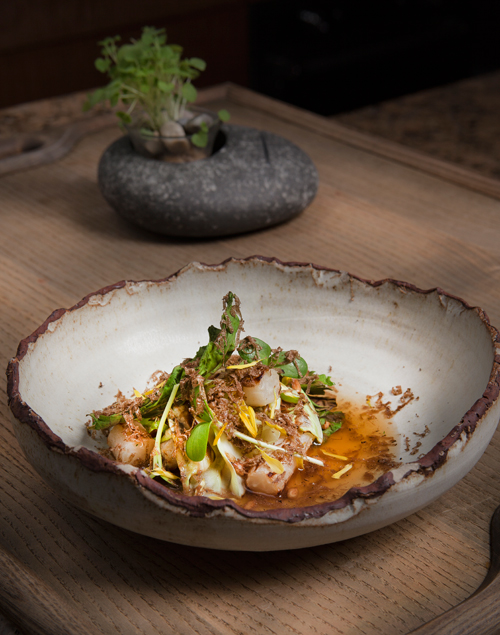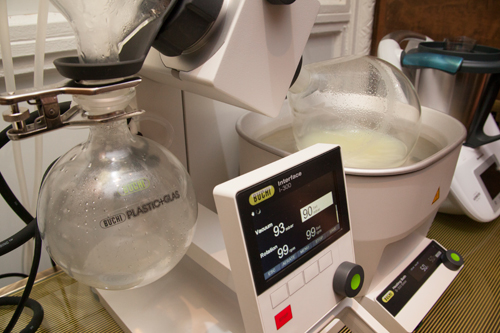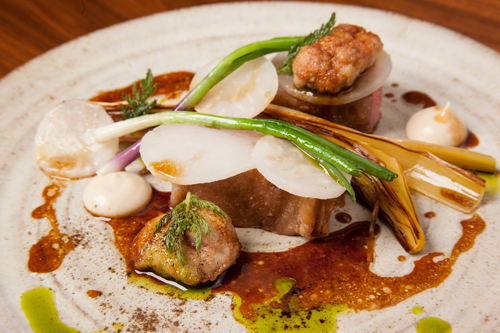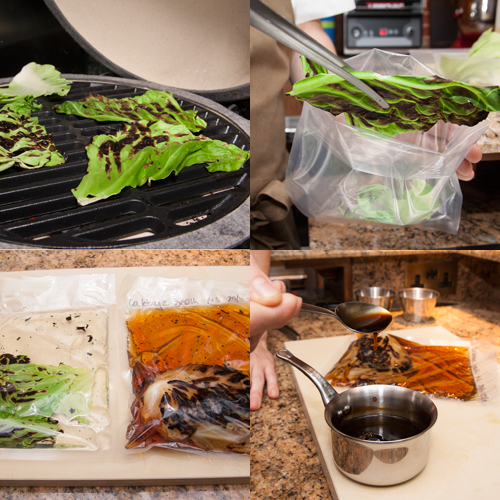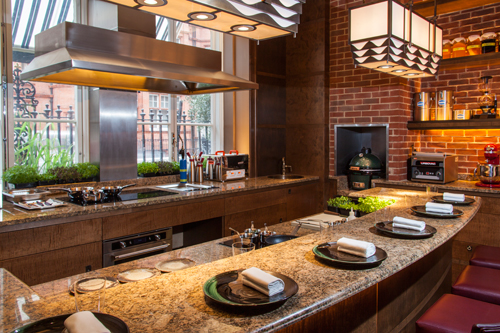Masterclass: Several ways with kohlrabi by Simon Rogan
Michael Raffael reports
It's a very un-British vegetable, is kohlrabi. The French grew it as ravacaulos in the early Middle Ages (today, chou rave). Its German name, the one we've adopted, approximates to "cabbage-turnip". In this form it reached England about 400 years ago. It has never quite caught on here, having never fitted in with our traditional meat and two veg formula. Prodfact, a guide to "agricultural and horticultural produce" published in the 1980s, claims English farmers once treated it as sheep feed.
Our home-grown recipes for cooking it often contradict each other. One claims that there is little point in undercooking it. A second suggests gentle steaming to extract its delicate flavour. A third advises turning it into coleslaw. According to André Simon's culinary encyclopaedia, the flavour is closest to the skin so it shouldn't be peeled. Another authority says the outer casing is too woody to eat. Nor is there any agreement as to its seasonality. Does the harvest last from July until the end of November, or continue until February? It deserves a better fate.
Simon Rogan grows it on his 12-acre Cumbrian farm. When the winter kicks in up north, he'll switch to his two South West suppliers. It's one of his favourite greens, on his menus at L'Enclume, the French at the Midland hotel in Manchester, and Fera at Claridge's. In his Aulis development kitchen, he and his chefs continue to experiment with it.
Purchasing
Kohlrabi isn't a root vegetable - the bulb grows above ground. Its colour can vary on the outside from purple to green to white, but this is only skin deep and won't affect any recipe. Size varies: small ones may be no bigger than clementines, whereas large ones are as big as grapefruit and weigh about 400g. This is no indication of taste or tenderness. To check freshness, look at the spinach-like leaves at the top: they shouldn't have dried or wilted.
Basic preparation
Peel the outer skin as though preparing an orange for a fruit salad. Slice off the top and bottom, stand the kohlrabi on a work surface and pare off the skin in strips (1). Finished, it has a whitish colour similar to mouli. It also has a high moisture content - 85%-90% (potatoes are about 79%) - which influences Simon Rogan's approach to cooking it.
Pickled
At Fera, finely sliced discs of pickled kohlrabi are used as wonton wrappers (see below).
To make these, the vegetable has to be at least 8cm across at the waist after peeling.
To prepare a sweet pickle (the quantity depends on batch size), by volume, dissolve two parts sugar in three parts white vinegar in a pan. Bring to the boil and then take off the heat. Add one part iced water and chill.
Using a slicing machine set at 0.2 (the finest practical, wafer-thin setting), slice the kohlrabi (2) and cut out 6cm discs. For individual servings, put three to five discs in a vacuum pouch with approximately 50ml of sweet pickle and seal for 30 seconds at full pressure.
Evaporated juice
Although it's a member of the cabbage family (a brassica), kohlrabi has a sweetish taste that is distinctive when evaporated, and it also loses most of the raw cabbage flavour. A professional juicer will yield about 750ml juice from 1kg.
To make the evaporated juice for the wontons (see below), put 500ml juice in the Rotavapor water condenser and reduce it to 400ml. The machine in the Fera kitchen does this using automatic settings. The aim is to boil the liquid at 40°C by lowering the pressure in the sealed flask to 90 bars. This concentrates the flavour without denaturing it.
Note: For the veal wontons, Fera blends four parts evaporated kohlrabi juice with one part apple juice and colours it with spinach juice.#
Salt-baked
Salt-baking kohlrabi is very similar to salt-baking celeriac. The time will vary according to the size of each individual piece.
For the Cornish lamb recipe (see box, right) or for the grilled kohlrabi recipe (see box, far right), make a basic salt dough out of two parts plain flour mixed with one part coarse sea salt (3). Add enough cold water to make soft, easily rolled dough (4).
For one peeled kohlrabi weighing about 300g, roll out 200g salt dough (5). Place the vegetable in the middle (6), pull the sides together and seal (7). Bake in a preheated oven: 15 minutes at 220°C and 25 minutes at 180°C. Leave to cool and set aside. Before using, break the salt-crust shell and discard it (8).
Smoke-grilled
Take a standard apple corer. Cut four or five cylinders from a salt-baked kohlrabi per portion (9).
In a preheated grilling Green Egg barbecue, brush the ceramic sheet that fits above the grill with oil and ensure it has heated up. Add a teaspoon of chosen wood flavouring - hickory, etc - to the embers. Lay the pieces of kohlrabi on the ceramic cooking stone, add a tablespoon of fine woodchips - oak, etc - and grill with the lid closed to keep in the smoke until the kohlrabi is caramelised and starting to char - about five minutes (10).
Grilled kohlrabi and cabbage smoked over embers, sunflower seed and truffle
Serves 1
- 3-4 cylinders of smoke-grilled kohlrabi
- 3-4 fresh kohlrabi leaves
- 2-3 large hispi cabbage leaves
- 1tbs truffle custard (see below)
- 1tsp roasted sunflower seeds
- Sunflower shoots
- Sunflower or chrysanthemum petals
- Grated truffle (type according to season)
- 2tbs cabbage liquor reduction (see below)
While the cylinders of kohlrabi are broiling, dry out the kohlrabi leaves on the griddle/plancha.
Cut the central ribs out of the hispi leaves and tear the leaves into large irregular shaped pieces. Grill them alongside the kohlrabi in the egg.
To assemble, spoon the custard in the centre of the plate. Lay the broiled kohlrabi on top with the leaves. Arrange the seeds to one side with sunflower shoots sprinkled over them. Finish with the flower petals and grated truffle and serve the reduction separately in a jug.
Rotavapor
Evaporators started to become popular in the early days of molecular cuisine, but have become established as a piece of worthwhile kit in high-end restaurants. Simon Rogan describes them as "the next step up from sous vide cookery and the natural flavour enhancer".
Their main use is in distilling flavours. If a chef wanted to produce any reduction, they would, in the past, have had to boil and reduce it. The Rotavapor lets them do this without cooking it and altering its intrinsic taste or destroying nutrients and antioxidants. The equipment lowers the pressure in a sealed container which, in turn, lowers a liquid's boiling point. As a result, vapour evaporates slowly, but the liquid's taste slowly concentrates. In the past, chefs learnt by trial and error how to adapt the technology to recipes. It's now possible to buy equipment that operates with automatic settings.
Fera uses equipment supplied by Swiss manufacturer BÁ¼chi (www.buchi.com)
Steamed egg custard with truffle
Makes approximately 15 portions
- 3 yolks
- 1 egg
- 200ml double cream
- 200ml milk
- 15g summer truffle
- Salt
Steam until set.
Cornish lamb, sweetbreads, salt-baked kohlrabi, leek and yarrow
Served as a main course. The loin of lamb is smoke-grilled in the Green Egg. Lambs' sweetbreads are floured and fried in butter. A pencil leek is grilled to order, together with two spring onions.
For each portion, slice salt-baked kohlrabi about 3mm thick. The number of slices depends on their size, but allow about 30g.Reheat them in a butter and water emulsion.
Put two pieces of loin in the middle of the plate with the leek between them. Lay the kohlrabi on top, then the sweetbreads and spring onions. Pipe a little white onion purée around the side. Finish with a concentrated lamb gravy and sprigs of yarrow.
Cabbage liquor sauce
Barbecue 1kg large cabbage leaves until the ribs start to char. Put them in large vacpacks with about a litre of water. Seal for 30 seconds at 100% pressure. Poach in a water bath for 12 hours at 80°C. Cool and strain to obtain a dark, clear broth. Reduce to a concentrated flavour, season and thicken with smart starch. Makes about 150ml.
Raw veal and oyster, apple and fresh kohlrabi juice apple marigold
This dish is served on the tasting and Á la carte menus. It's a starter of veal and oyster in kohlrabi wonton wrappers in a warm juice-broth.
Blast-freeze a loin of rose veal until just-frozen. Cube it and season with salt, Tabasco and virgin rapeseed oil.
Boil native oysters in their shells for 20 seconds then cool, shuck and dice. Make a separate emulsion with 12 oysters, 60g egg white, 120g rapeseed oil and lemon juice.
Fill three pickled kohlrabi wontons with about 40g veal, diced oyster and ½tsp of emulsion per wonton. Seal to form parcels.
Plate in a soup bowl and pour the kohlrabi apple juice around them. Finish with apple-marigold sprigs.
Aulis
Eighteen months after opening Fera at Claridge's, Simon Rogan has added a bolt-on development kitchen, Aulis. By day it will help his team create new dishes. At night, it will host tastings for up to six diners, where they will be able to interact with chefs preparing them a specially tailored meal.
The concept, he believes, will repeat the success of the original Aulis at his L'Enclume headquarters in Cartmel, Cumbria. "With the help of my executive chefs, I lead," he says, "but each Aulis has its own director and team."
Fera opened in May 2014. The development kitchen, always part of the original project, has taken a year to complete and was designed by Guy Oliver, who revamped the restaurant after Rogan took over from Gordon Ramsay, to blend the hotel's classic art deco style with cutting edge culinary technology.
Diners sit on stools at a counter and interact with the chefs preparing their meal. They may not notice the vacuum evaporator, freeze-dryer, assorted blenders and juicers or Big Green Egg barbecue, central to the Rogan style. The basic charge is £150 per head, plus an optional £130 for wine parings. The menu itself will be bespoke and a surprise on the night, with dietary requirements catered for if the table is booked exclusively.
"It's not about treating people like guinea pigs," says executive chef Dan Cox. "These new dishes are ready and we want an interface with the public, so we can tweak things if that seems a good idea."
Rogan's prime objective, he insists, "is to make Fera stronger". Aside from giving a bespoke service, the kitchen has a pragmatic function. All the new dishes devised and perfected for Fera will emanate from here. He conceded that he has had to delegate and trust his chefs to take on some of the innovation which he mostly did himself: "The creativity and desire are still there. We are very much a team now - a committee of professionals, trying to perfect the job together."
It's a tried and tested formula. Simon and his team put together the whole of the original Fera menu in the Cartmel Aulis before bringing it to London for the launch.
There's an added synergy. Alex Beard, previously at the Waterside Inn, has been appointed head of Aulis at Fera, and he and the London team will collaborate with their Cumbrian sister.
As theatre, a restaurant's development kitchen is becoming a kind of Royal Box, a notch up from the chef's table. It has, though, a more pragmatic function. In the pressure of a busy kitchen it's sometimes difficult to innovate, given the complexity of some dishes. Aulis gives Rogan's team the time and space to perfect new recipes, to explore innovation and new ideas, and to allow the culinary talent to flourish.
Simon Rogan
Simon Rogan admits that he was once a technique freak: "In the past, techniques overrode flavour and the ingredient," he says. But that position has changed. As the owner of a 12-acre farm near his Cumbrian base of L'Enclume, he uses his knowledge of the chefs' armoury of skills to extract maximum taste from any fruit or vegetable that enters his kitchens.
"There's still lots of technique in our cooking, but you wouldn't notice it," he admits. "It's in the background; very subtle. We're not trying to deconstruct and reconstruct any more. We want to let the ingredient sing and not do too much to it."
It isn't just his approach to cooking that changed. The string of accolades that has come his way masks the fundamental shift that has turned him from chef-patron into restaurateur.
Simon Rogan with Dan Cox, executive chef at Fera
"Until two or three years ago the lion's share of the creative input came from me, but I've learned how to delegate. I've found soulmates [like Dan Cox, his executive chef at Fera, Tom Barnes at L'Enclume and Adam Reid at the French] with whom I can share ideas and trust. It's something I needed, because you can't go on by yourself for ever. Once you have multiple operations, the creativity is still there, but it's harder to bring it out."
Although L'Enclume has two Michelin stars and Fera got one within four months of opening, Rogan argues that he never has stars in his eyes when planning a new project: "If I was thinking of that kind of recognition, I wouldn't use half the ingredients I have on my menu. I wouldn't take half the risks I take on my menus, so it's not about that. It's about being happy with what we're doing. It's about customers being happy. And it's about creating a profitable business. A lot of people forget about that."
Continue reading
You need to be a premium member to view this. Subscribe from just 99p per week.
Already subscribed? Log In






